Bulletin – September 2010 Ownership of Australian Equities and Corporate Bonds
- Download the article 347KB
Abstract
Australian financial and non-financial companies tap capital markets – particularly equity and bond markets – to source funds from households, foreign investors and domestic institutional investors. Foreign investors supply around half of these funds, with institutional investors providing most of the remainder; households' direct holdings are comparatively modest. During the financial crisis, foreign investors' appetite for Australian assets remained strong, underpinned by the strength of the Australian financial system and economy.
Introduction
Capital markets are a major source of funds for many Australian financial and non-financial companies. Correspondingly, this financing activity provides investment opportunities for Australian and non-resident investors. This article looks at the types of investors who provide the funds raised by Australian entities in bond and equity markets – the main avenues of capital market funding – by examining the composition of the investor base.[1] It also details the notable changes in the ownership of Australian entities and bonds since the early stages of the financial turmoil in mid 2007 when there were signs of dislocation in some capital markets.
In this article, investors are grouped into three broad categories:
- Australian households – this category covers households' direct holdings only and does not include investments in managed funds or superannuation;
- Australian institutional investors – this group is mostly made up of households' indirect holdings of assets in superannuation and other managed funds, as well as holdings by authorised deposit-taking institutions (ADIs) and insurance companies; and
- foreign investors.
Foreign investors make up around half of the investor base for the combined value of Australian equities and bonds. This is consistent with portfolio diversification by global investors, who, by virtue of their size can account for a large share of the investor base of Australian assets whereas Australian investors only make up a small share of investors internationally. Institutional investors own the bulk of the remainder; as a large share of household wealth is invested indirectly through superannuation and managed funds, households' direct holdings are relatively small.
Overall, investor demand was resilient during the financial crisis, enabling Australian entities to raise a substantial volume of funds. Foreign investor demand for Australian financial assets – with the exception of securitised products – remained strong.[2] Despite considerable uncertainty and volatility globally, foreign investor appetite for Australian assets was underpinned by the relative strength of the Australian financial system and economy compared to most advanced economies. The depreciation of the exchange rate may have also contributed to foreign demand, by making Australian dollar denominated assets cheaper. During the crisis period, domestic demand for financial assets softened a little in an environment of increased risk aversion, but investors continued to participate in new equity and bond issuance.
Equity Ownership
Australian companies predominantly raise public equity domestically by listing on the Australian Stock Exchange (ASX); only a handful of companies have secondary listings overseas. The ASX has a current market capitalisation of around $1,300 billion, equivalent to 100 per cent of GDP.
Prior to the financial crisis, institutional investors were the largest single class of investor, owning almost half of listed Australian equities (Graph 1). Institutional ownership had increased significantly over the years leading up to the financial crisis due to the growing pool of funds under management from compulsory superannuation contributions and an increasing portfolio allocation to Australian equities. Contributing to this broader trend, superannuation taxation reforms introduced in May 2007 gave households an incentive to increase their superannuation investments before July 2007.[3] This contributed to a small decline in the proportion of the market owned directly by households to around 20 per cent just prior to the financial crisis, as some households funded extra superannuation by reducing their direct holdings.
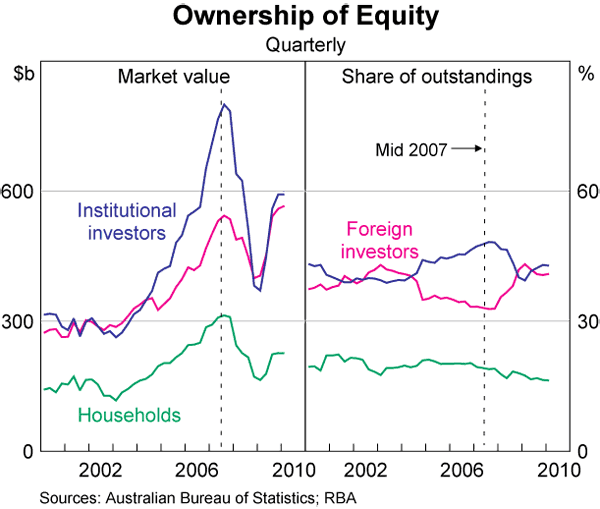
Institutional investors, and to some extent households, also diversify their portfolios by investing in global equities. Correspondingly, foreign investors invest in the Australian share market, and accounted for around one-third of the investor base in mid 2007. The performance of the domestic economy in the lead up to the financial crisis underpinned the stock market's strong returns, and contributed to Australia being an attractive destination for foreign investment.
Falls in equity prices since the start of the financial crisis saw the market capitalisation of the Australian stock market decline by 14 per cent between mid 2007 and March 2010 – the latest date for which ownership data are available (although the fall was larger from the peak in November 2007 to the trough in March 2009). As a result, the three classes of investors all experienced a decline in the value of their holdings of equities, with share price falls more than offsetting any purchases of newly issued equity or transfers between investors.
There has also been a change in the distribution of ownership across the different classes of investors. Considering only net flows and abstracting from valuation changes, it is clear that foreign and household demand for Australian equities softened at the onset of the financial crisis, with institutional investors buying virtually all of the (relatively modest) equity issued by listed companies in the second half of 2007 (Graph 2). However, institutions scaled back their purchases significantly over 2008, in part reflecting fund managers increasing cash holdings as a precaution against possible redemptions by investors and also more general portfolio reallocation.
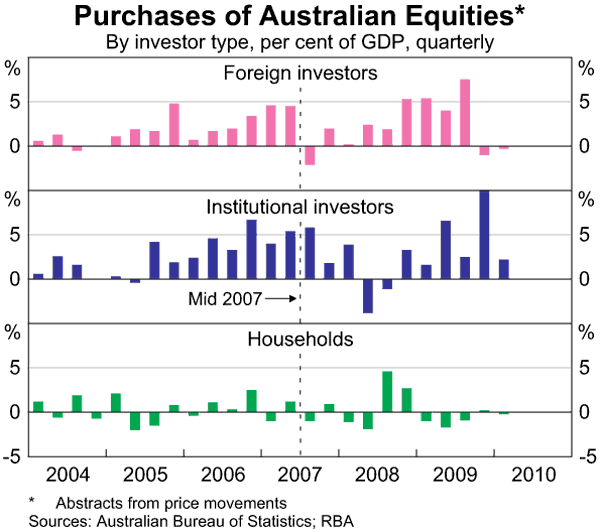
Foreign investor demand increased through 2008, underpinning the large volume of equity raisings undertaken by Australian companies during the financial crisis. Banks mostly raised funds in late 2008 and the middle of 2009, to boost already-sound capital ratios, while non‑financial corporates reduced gearing by raising a record amount of equity to pay down debt in 2009. Overall, investor demand for the new shares was strong, with many issues oversubscribed, partly because investors could usually purchase the new shares at a modest (and in a few cases, large) discount to prevailing market prices.
Foreign participation in both the financials' and corporates' equity raisings was high throughout this period, with market reports suggesting that some foreign investors increased their portfolio allocation of Australian assets. While households – whose portfolios are heavily skewed toward shares of financial institutions, as discussed below – purchased a significant volume of the new shares issued by banks in the second half of 2008, in other periods they sold equities to increase their cash deposits in response to the uncertain environment. Institutional investors' demand for equities increased over 2009 as risk aversion eased, purchasing large volumes of corporates' equity raisings.
As a result of these developments, the share of the market owned by foreign investors has increased sharply over recent years to be around the same level as institutional investors (whose share declined), at around 40 per cent. Households' share fell a little to 16 per cent. Despite this fall in households' direct ownership of equities, the proportion of individuals that own shares remains relatively high by international standards, with the ASX estimating that around 40 per cent of the adult population holds shares, either directly or through managed funds (excluding in superannuation).
The sectoral portfolio allocations of households, institutional and foreign investors differ significantly. Institutional investors' portfolio allocation is broadly consistent with the composition of the share market, holding around 30 per cent in financial stocks and 70 per cent in non-financials (Table 1). This partly reflects the tendency for their performance to be benchmarked against share market indices. In contrast, Australian households have a greater portfolio allocation to financials (making up around two-thirds of their holdings), whereas foreign investors hold more non‑financial corporates (which make up 80 per cent of their holdings). Households' high holdings of financial stocks, in part, reflect a preference for high‑dividend yielding stocks from which they typically receive a steady cash flow. Privatisations and demutualisations in the 1990s also boosted households' overall direct share ownership, with a large share of these being financials (such as AMP, CBA and NRMA).
| Total | Investors | |||
|---|---|---|---|---|
| Households | Institutional investors |
Foreign investors | ||
| Financials (excl real estate) | 30 | 65 | 30 | 20 |
| Non-financials | 70 | 35 | 70 | 80 |
| Total | 100 | 100 | 100 | 100 |
|
Sources: Australian Bureau of Statistics; ASX; RBA |
||||
Taxation treatment of dividends also influences investor behaviour; non-resident investors cannot utilise dividend imputation franking credits, providing a relative incentive for foreign investors to hold non-financial stocks that tend to have lower dividend payout ratios. Foreign investors also invest in Australian non-financial stocks to gain exposure to resource companies, as the Australian share market has a disproportionately large share of resource companies (available data do not break down non-financial holdings into categories such as resources). These trends in portfolio allocations across investors did not vary greatly during the financial crisis.
Overall, households and institutional investors own the bulk of financial stocks (33 and 41 per cent respectively), with foreign investors owning the remainder (26 per cent). In contrast, foreign investors are the largest holders of non-financial stocks (48 per cent), with institutional investors also owning a large share (44 per cent) and households a small share (8 per cent).
Bond Ownership
Bonds issued by Australian non-government entities can be broadly grouped into three categories:
- financials;
- non-financials; and
- asset-backed securities (ABS).
At around $800 billion, the market value of Australian non‑government bonds outstanding is a little over half the value of the market capitalisation of ASX‑listed equities, and equivalent to around 60 per cent of GDP. While companies predominantly raise equity funding on the domestic market (i.e. the ASX), it is common for them to access foreign debt markets by issuing bonds offshore, with around 60 per cent of the stock of bonds outstanding having been issued offshore. While Australian entities tap offshore markets to source funds from foreign investors, non‑resident investors also own around one-third of bonds issued into the domestic market, such that they make up over two-thirds of the investor base of total Australian bonds (Table 2).
| Total | Financials | ABS | Non-financial corporates | ||
|---|---|---|---|---|---|
| $ billion | Per cent | Per cent | Per cent | Per cent | |
| Foreign investors | 530 | 69 | 71 | 52 | 79 |
| Institutional investors | 235 | 31 | 29 | 47 | 21 |
| Of which: | |||||
| ADIs | 81 | 11 | 12 | 19 | 4 |
| Insurance companies | 30 | 4 | 3 | 3 | 5 |
| Super and managed funds | 77 | 10 | 7 | 18 | 10 |
| Government and other(a) | 47 | 6 | 7 | 7 | 2 |
| Households | 2 | 0 | 0 | 1 | 0 |
| Total | 767 | 100 | 100 | 100 | 100 |
|
(a) Includes bonds held under repurchase agreement (repo) by the Reserve Bank for open market operations, other government holdings (such as those of the Future Fund and the Australian Office of Financial Management) and private non-financial corporations' bond holdings. Sources: Australian Bureau of Statistics; RBA |
|||||
In contrast to the share market, households' direct participation in the bond market is very limited, at less than 1 per cent of all Australian bonds on issue. This low participation reflects two main factors. First, Australia's compulsory superannuation scheme produces a pool of household savings that is invested via the funds management industry rather than directly by households. Second, the disclosure requirements for issuers that raise funds from retail investors mean that it has usually been more cost effective to raise debt funding from institutional investors, although the Australian Securities and Investments Commission (ASIC) has recently announced initiatives to make it easier to issue to households. These factors have contributed to institutional investors' large holdings of bonds, at around three-quarters of bonds on issue domestically and one-third of all Australian bonds.
There was little change in the ownership of the Australian bond market at the aggregate level during the financial crisis, though there have been marked changes in the composition of ownership at the sectoral level which are discussed further below.
Financials
There was strong investor demand for bonds issued by financial institutions – the bulk of which were issued by the major banks – over the decade prior to the crisis, with the value of the stock of bonds outstanding increasing at an annual rate of around 15 per cent. Foreign investors owned around 80 per cent of all financials' bonds on issue in the years leading up to the crisis (Graph 3). As well as buying almost all bonds issued offshore, foreign investors' participation in the domestic market increased to around one-quarter of the investor base over this period. Foreign ownership was supported by the introduction of withholding tax exemptions and the liquid swap market that allows non-resident investors to cost-effectively hedge their Australian-dollar investments into their local currency (and conversely Australian entities to hedge their foreign currency exposures into Australian dollars).
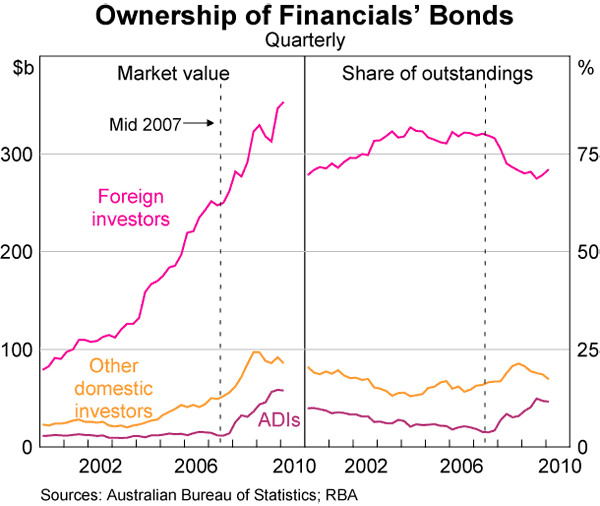
During the financial crisis, the rate of growth of financials' bonds outstanding increased to around 20 per cent per annum as banks substituted toward more stable, longer term sources of wholesale funding. Investor demand for Australian banks' bonds remained strong, underpinned at the peak of the crisis by the introduction of a guarantee by the Australian Government and strong investor appetite for highly rated debt. In contrast to the previous decade, when bonds outstanding offshore increased more rapidly, the stock of bonds on issue domestically increased at a faster rate during the crisis, in part reflecting the greater strains in markets offshore.
A relatively large share of the banks' bonds issued domestically during the financial crisis was purchased by other banks, with this share increasing from less than 5 per cent prior to mid 2007 to peak at almost 15 per cent in late 2009. Banks bought other banks' bonds to increase their holdings of liquid assets that could be used as collateral in the Reserve Bank's open market operations.
Foreign investors' share of financial bonds outstanding decreased a little during the financial crisis, though foreign investors continued to purchase a large volume of bonds and account for the bulk of the investor base. At the peak of the crisis, following the collapse of Lehman Brothers, investor appetite for banks' bonds globally evaporated and foreign investors sold bonds in the September quarter 2008 (Graph 4). Demand resumed in 2009, initially for guaranteed debt, though increasingly for unguaranteed bonds as conditions in financial markets improved and investors became more willing to hold bank credit risk. Prior to the Australian Government Guarantee Scheme ceasing for new issuance in March 2010, around $165 billion of guaranteed bonds had been issued by banks, over two‑thirds of which were sold to foreign investors – in line with the share prior to the financial crisis.
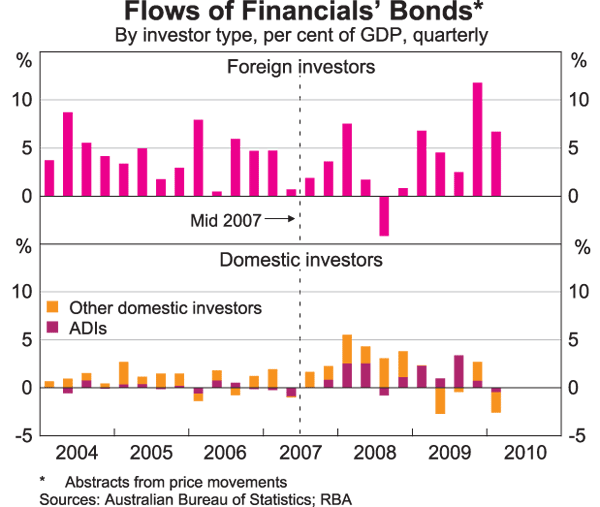
Asset-backed securities
The ABS market – which largely consists of residential mortgage-backed securities (RMBS) – experienced rapid growth in the lead up to the financial crisis with strong demand from institutional investors and foreign investors reflected in a steady decline in RMBS spreads. Foreign investors made up around 60 per cent of the ABS investor base prior to mid 2007, purchasing both ABS issued offshore as well as increasingly buying ABS issued into the domestic market (Graph 5).

Securitisation markets globally were greatly affected by investors' reappraisal of risk following the collapse of the US sub-prime market in 2007. Although the Australian securitisation market did not have the problems of poor transparency, overly complex structures and low credit quality that were a feature of the US market, investor appetite for Australian structured credit also dried up.[4] Distressed leveraged foreign investors including structured investment vehicles (SIVs) – which used to account for around one-third of the investor base – not only stopped purchasing new RMBS issues, but were forced to sell their holdings of Australian ABS, alongside the sales of other assets, when they could not roll over the asset‑backed commercial paper used to fund their operations.
In total, the value of foreign investors' holdings of ABS has more than halved since its peak in mid 2007, and now amount to around half of Australian ABS, down from 60 per cent at the onset of the crisis. The decline in holdings reflects maturities and ongoing amortisation (i.e. mortgage repayments), sales to domestic investors as well as lower valuations (Graph 6 shows the flows in foreign holdings, abstracting from valuation effects). While there are signs that foreign investors are starting to return to the market, with some participating in recent RMBS transactions, a significant portion of the investor base has disappeared with the demise of the SIVs.
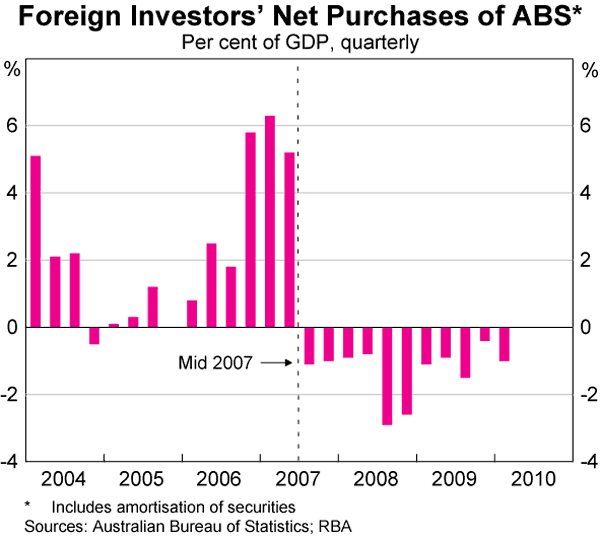
The appetite for structured credit by resident superannuation and managed funds also diminished; these institutions' holdings of ABS declined by around 45 per cent, to $30 billion, to be a smaller share of their total asset holdings. The rate of decline is broadly consistent with amortisation over this period – on average, RMBS pay down in 3 to 4 years – which suggests that these funds mostly held their investments but, in net terms, did not undertake many new purchases, consistent with the limited issuance that took place during this time. In contrast, ADI's holdings were broadly flat, suggesting that purchases of RMBS offset amortisation.[5] In part, this likely reflected ADI demand for liquid assets, as the Reserve Bank extended the range of collateral eligible for its open market operations to include RMBS.
Significant support for new issues of RMBS during the financial crisis was provided by the Australian Office of Financial Management (AOFM). In October 2008, the Australian Government announced an $8 billion program to support competition in the mortgage market whereby the AOFM would be the cornerstone investor in new RMBS issues. This program was extended in November 2009, with a potential additional $8 billion of purchases announced. The AOFM now holds around 8 per cent of all Australian ABS on issue. There has been an improvement in conditions in the Australian securitisation market since the peak of the financial crisis, with the AOFM's participation in deals declining and a number of new deals without AOFM support (Graph 7).
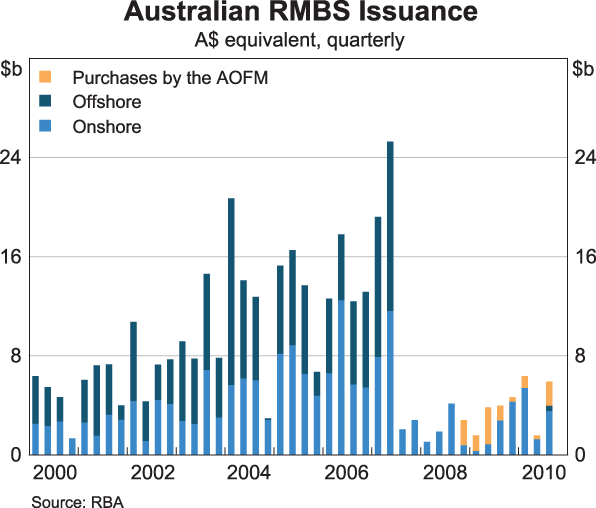
Non-financials
The large non-financial corporates that tap bond markets have historically sourced around two-thirds of these funds from foreign investors. In part this reflects differing domestic and foreign investor appetite for credit risk. While almost all Australian corporates that access bond markets are rated investment grade, most are rated BBB and domestic investors, particularly managed funds with investor mandates, tend to have a preference for higher-rated bonds. Indeed many corporates that did issue domestically often boosted the rating of the bonds by having them ‘credit-wrapped’.[6] In contrast, it was easier for lower-rated corporates to tap the large heterogeneous foreign investor base that underpins the larger offshore markets, such as the US private placement market.
During the financial crisis, most new issuance took place offshore to foreign investors (Graph 8). Most of the large bond issues were undertaken by resource companies that had an established presence in the US market. In contrast, there were limited bonds issued into the domestic market; domestic investors' holdings have declined since mid 2007 (by 20 per cent) due to bond maturities more than offsetting purchases. Recently there have been signs that domestic investors are returning to the market, with investors making net purchases in early 2010.
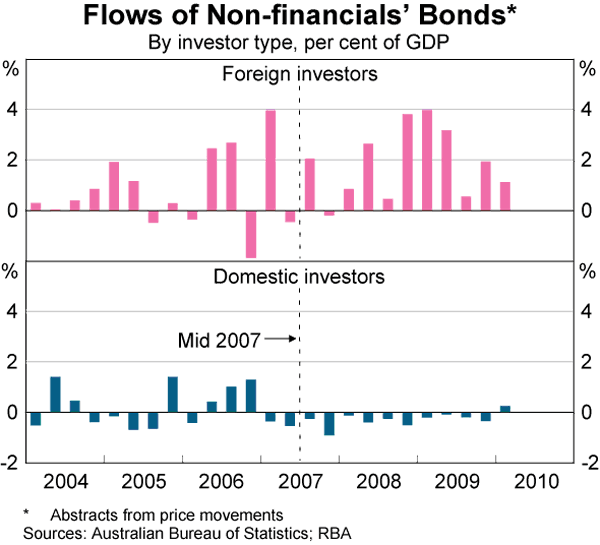
The value of foreign investors' holdings has risen sharply since mid 2007 (by around 65 per cent), such that foreign investors now hold a little over three-quarters of the stock of corporates' bonds outstanding (Graph 9). The increase in foreign investors' holdings over this period mostly reflects some large bond purchases. The value of bond holdings (in Australian dollar terms) was also affected by significant movements in the exchange rate during the period – as foreign investors' holdings of corporate bonds are mostly denominated in US dollars – though the overall effect of exchange rate movements on holdings was small. While the significant depreciation of the Australian dollar in late 2008 sharply boosted the Australian dollar value of US dollar denominated bonds, the broadly equivalent appreciation over 2009 largely unwound this effect. Foreign investors' holdings were largely flat over 2009, with the valuation effect offset by large bond purchases. The willingness of foreign investors to purchase these bonds suggests they were comfortable taking on credit risk associated with the Australian economy, albeit at higher spreads, and continued appetite for exposure to resource companies.
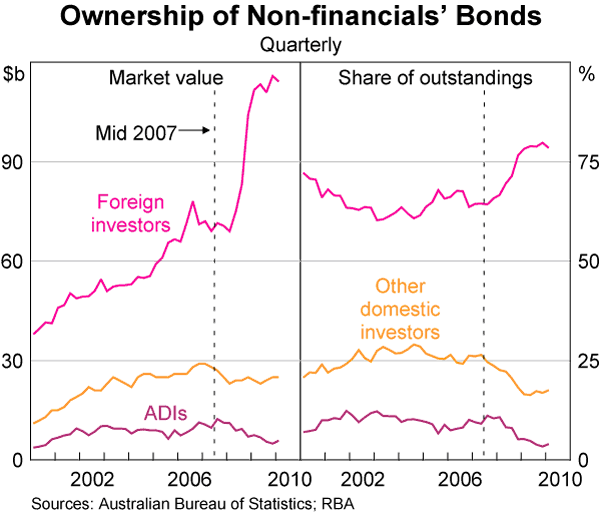
Conclusion
Foreign investors provide around half of the total funds that Australian companies source in equity and bond markets. Institutional investors make up the bulk of the remainder, with households owning a relatively small share. During the financial crisis, the share of the equity market owned by foreign investors increased a little, with foreign demand remaining resilient. There was little change in the ownership of the Australian bond market at the aggregate level during the financial crisis, though there have been marked changes in the composition of ownership at the sectoral level. Notably, many distressed leveraged foreign investors sold their holdings of Australian ABS, thereby reducing the share of the securitisation market funded by foreign investors. The share of financials' bonds held by foreign investors also decreased a little – despite a large volume of purchases throughout the period – as Australian banks purchased other banks' bonds to boost the liquidity of their balance sheets. At the same time, foreign investors purchased a higher share of non-financial corporate bond issuance.
Footnotes
The authors completed this work in Domestic Markets Department. [*]
Companies also issue short-term debt, though this source of funds is comparatively small. The Australian Bureau of Statistics Financial Accounts data used in this article classify convertible hybrids as bonds until converted to shares. [1]
For a broader discussion on capital flows during this period, see D'Arcy and Ossolinski (2009). [2]
Under a transitional arrangement, households could make up to $1 million in undeducted (after-tax) contributions to superannuation between 10 May 2006 and 30 June 2007, before new caps on super contributions (of $150,000 per annum) commenced from 1 July 2007. [3]
See Debelle (2008) for a comparison of the Australian and US securitisationm markets. [4]
This excludes so-called ‘self securitisations’, which were held on balance sheet. [5]
This is a type of credit enhancement whereby a bond insurer guarantees to meet interest and principal payments if the issuer defaults. [6]
References
D’Arcy P and C Ossolinski (2009), ‘Australian Capital Flows and the Financial Crisis’, RBA Bulletin, November, pp 1–6.
Debelle G (2008), ‘A Comparison of the US and Australian Housing Markets’, Address to the Sub-prime Mortgage Meltdown Symposium, Adelaide, 16 May.